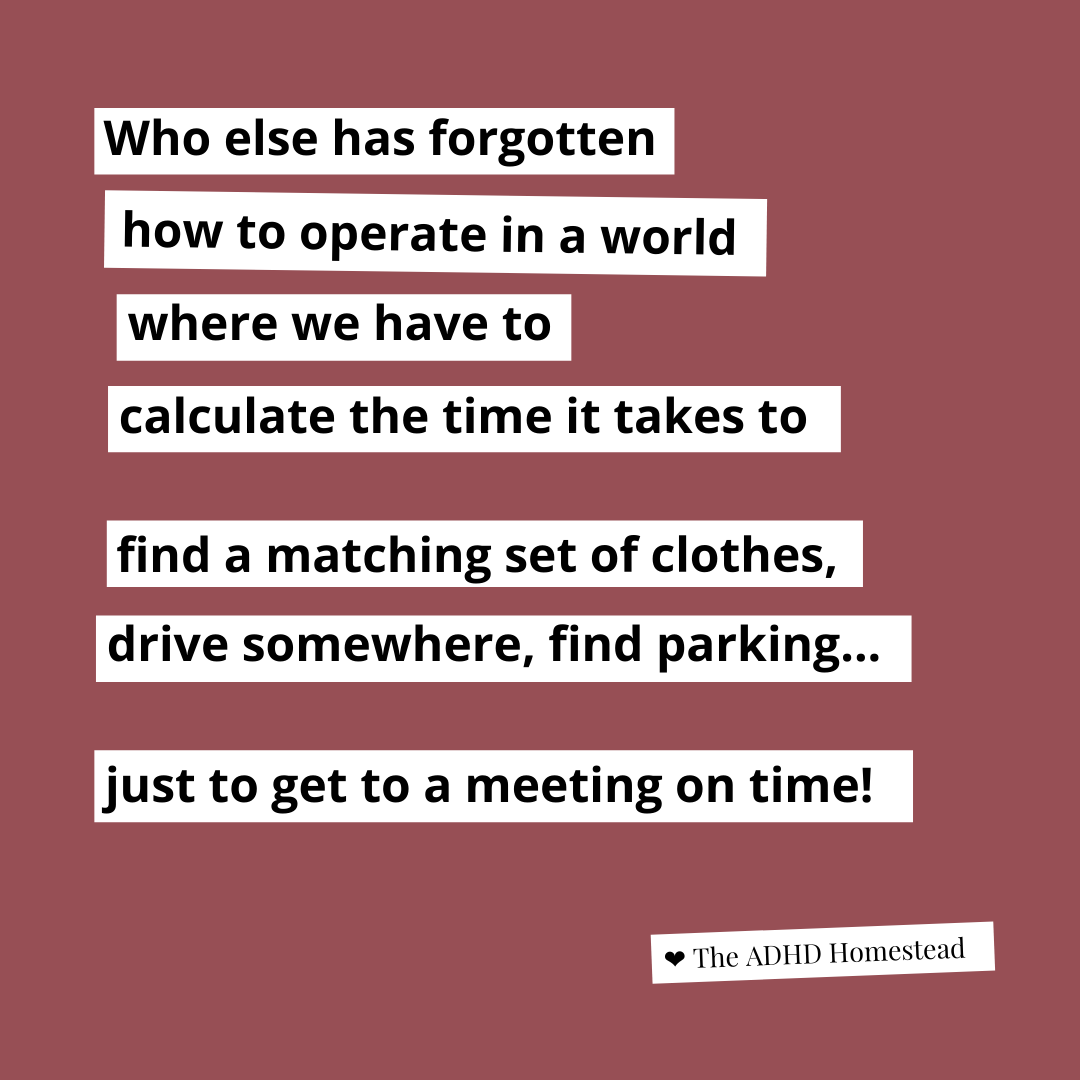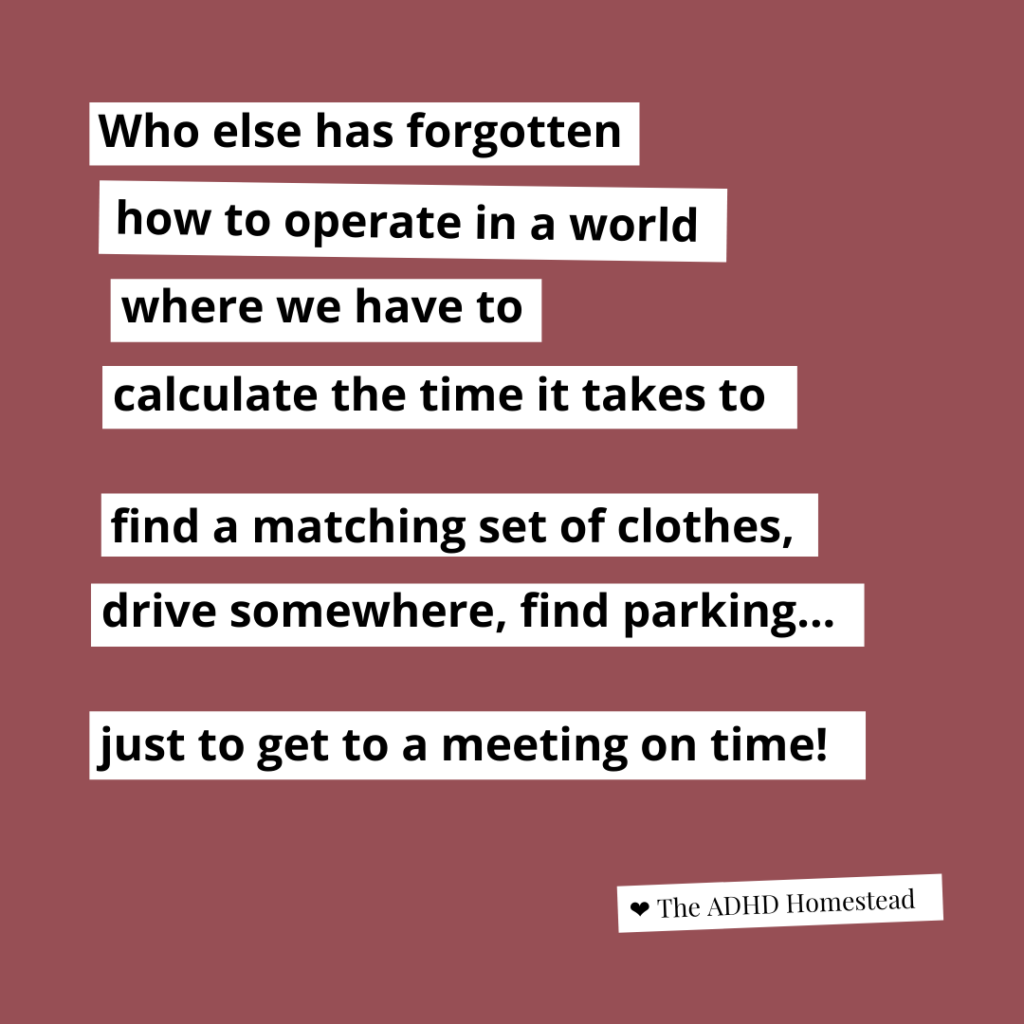I recently had a stressful experience getting my covid-19 vaccine. Nothing went wrong. I didn’t have concerns about the vaccine. I was ready to get it, and I even cried a little when they handed me my card. One hundred percent of my stress came from having to arrive at a specific place, at a specific time.
It’d been a while. I got out of practice during the pandemic.
I had wanted to write about morning routines today. Many of us will return to work and school outside our homes soon, if we haven’t already.
But morning routines aren’t the problem. They simply reveal the extent of our struggle to prepare for departure from one place to another, and to do it on the real world’s timeline.
It’s working memory again
Like so many aspects of life with ADHD, this leads back to our faulty time perception (a.k.a. time blindness) and working memory.
Our brain’s working memory allows us to hold more than one thing in our heads at once as we think through a problem.
Or at least it should.
Many ADHDers have a weak, or leaky, working memory. This means my morning routine or this vaccine appointment make sense as one big thing — e.g., “I need to get to the clinic for a 2:00 p.m. appointment” — but I have trouble breaking it down. The details that would tell me what time I need to start getting ready and eventually leave the house remain out of focus.
These working memory struggles combine with poor time perception to create a real mess. Even if I complete a task every day, I often have a very poor sense of how long that task takes. Many of us struggle with this in our morning routines. We allow the amount of time we think everything should take, yet always end up rushing out the door late.
How to get out the door on time, part one: when do I need to walk out the door, anyway?
Because my working memory is so unreliable, I need to work all these issues out on paper. I simply cannot translate the information, “I have a vaccine appointment at 2:00” or “I need to be in the office by 9:00” into anything useful in my head.
So I write it down.
First I identify the time I need to walk out the door. That means making a list of everything that could take time between the door and my destination. In the case of the vaccine appointment, that means:
- Warming up the car, connecting my phone, and picking out something to listen to
- Driving to the mall, where the clinic is located
- Finding a place to park
- Walking into the mall
- Finding the clinic once inside
- Checking in the registration table
The vaccine clinics seem to want people to arrive as close to their appointment as possible, so I should show up at the registration desk at around 1:55. It’s an unfamiliar mall, and I’m really no good at finding my way around malls, so I want to leave myself fifteen minutes to get in the door and find the place. The drive should take twenty-five minutes, but I’ll leave thirty in case I make a wrong turn or have to circle back to the correct parking lot. Let’s allow five minutes for me to sit in the car and get situated at the beginning of my journey.
Okay, now I have forty-five minutes’ worth of stuff, even though my Maps app says it’s a twenty-five-minute trip. That means if I try to leave the house at 1:30, I’m going to start panicking when I see the minutes ticking by and realize I will somehow still be late.
If I want to arrive at the clinic by 1:55, I need to walk out the door by 1:10.
How to get out the door on time, part two: what do I need to do to get ready?
Knowing when I need to leave is a huge step in the right direction, but it only helps if I can get myself ready in time. ADHD makes this difficult, too.
For the same reason we have trouble estimating how much time and work a big project will take, we struggle to get a sense of what needs to happen before we walk out the door.
That’s because “what needs to happen” almost always includes more than one thing. Our working memory doesn’t like that. When we try to think through abstract concepts like “getting ready” or “morning routine,” we overwhelm our brains. We can’t fit all the pieces in our heads at once. Often, we solve this problem by choosing a random time — “I’ll try to stop working ten minutes before I need to leave” or “an hour and a half should be enough time to wake up and get ready” — and hoping for the best.
Just like my travel time calculation, I often write down each individual thing I need to do to get ready. My vaccine was pretty easy: check my wallet for my insurance card (this could be done the day before), write some notes on how to find the clinic in the mall, download a few podcasts, put my wallet and sunglasses in my bag.
Timing this can take some trial and error. Even after writing down the steps, I still may not know how long all of them will take. Making my best guess on each one, then adding them together, still gets me a heck of a lot closer to the mark than making my best guess on the whole thing at once.
It’s all about working with what we have
When I think about it, I suspect many neurotypical people do this process intuitively. It doesn’t feel impossible or overwhelming to think about one’s morning routine, or the process to get out the door for an appointment, and estimate how much time they need. A lot of things probably feel more approachable with a fully-functioning working memory.
That will never be my reality.
One of the biggest things I’ve learned about having ADHD is I have to stop looking at what others are doing. I’ll get myself nowhere good thinking about what I “should” be able to do, or what “should” be a simple process. Many so-called simple processes don’t feel that way in my head.
And that’s okay! Needing to sit down and work something out on paper when most people can do it in their heads has no bearing on my worth. I still remember sitting in high school calculus, hearing my classmates rejoice whenever they didn’t have to show their work on an assignment, and wondering what was wrong with me. I literally couldn’t do the assignment without showing my work. How did others find this step expendable?
Years later, I would learn this is just the way my brain works. The more I fight it and try to do things like everyone else, the more I suffer.
So when I need to get somewhere on time, I break it all up and work it out on paper. Maybe it seems weird, but it saves me so much panic and chaos getting out the door — and that’s what really matters.
Hey there! Are you enjoying The ADHD Homestead?
Here's the thing: I don't like ads. I don't want to sell your attention to an advertising service run by the world's biggest data mining company. I also value my integrity and my readers' trust above all, which means I accept very few sponsorships/partnerships.
So I'm asking for your support directly. For the cost of one cup of coffee, you can help keep this site unbiased and ad-free.
Below you will find two buttons. The first lets you join our crew of Patreon pals and pledge monthly support for my work. Patrons also have access to my Audioblogs podcast. The second takes you to a simple donation page to pledge one-time or recurring support for The ADHD Homestead, no frills, no strings. Do whichever feels best for you!



